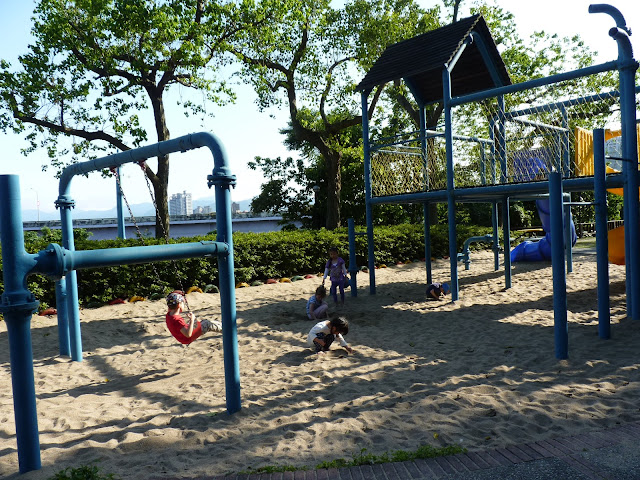Most of us would take kids to the Water Park in Taipei in summer to cool down. Well ... it's not summer yet so what were we doing there? No fountains, water slides, pools were open - too cold for Taiwanese people. There is a Museum of Drinking Water in the park, but the 3-5 year-olds were a bit too young for that. Besides it was a nature class!
And that's what we were doing - observing nature in the park.
This plant is very common in Taiwan. It's leaves are so big that you can use it as an umbrella. It's called giant taro or elephant-ear taro (Alocasia macrorrhizos - 姑婆芋 - Alokazja olbrzymia). Although this plant is not poisonous, you shouldn't touch it as it's sap (which feels like needles) can irritate the skin.
Taipei 101 can be seen from almost anywhere in Taipei :-) .
As on other mountains and hills in Taipei, there is a bunker here as well.
On the top of the Kuanying Hill there is reservoir on top of which there is a small meadow!
We are having some new friends joining the class.
And that's what we were doing - observing nature in the park.
Museum of Drinking Water is located in a Japanese era building (for more info follow the link). Maybe next time we will visit it inside?
Let me first show you the plants we observed:
This plant has spores on the under-leaf, just like other ferns. It it called nest fern (Esplenium nidus - 山蘇 or 鳥巢蕨 - Zanokcica gniazdowa). In Taiwan this fern can be eaten as a vegetable (I love it!), but in Hong Kong it is under protection.
This plant has spores on the under-leaf, just like other ferns. It it called nest fern (Esplenium nidus - 山蘇 or 鳥巢蕨 - Zanokcica gniazdowa). In Taiwan this fern can be eaten as a vegetable (I love it!), but in Hong Kong it is under protection.
We learned very interesting things about fig tree (Ficus Septica - 棱果榕 - rodzaj figowca). It's flowers are hidden inside a fig and get pollinated by only one species of wasp (Ceratosolen - fig wasp - 榕小蜂).
Yellow/Golden bamboo really has yellowish trunk:
Who would have thought that this is an orchid! Chinese spirantes (Spiranthes sinensis) is the world's smallest orchid. It's tiny and beautiful!
This plant is very common in Taiwan. It's leaves are so big that you can use it as an umbrella. It's called giant taro or elephant-ear taro (Alocasia macrorrhizos - 姑婆芋 - Alokazja olbrzymia). Although this plant is not poisonous, you shouldn't touch it as it's sap (which feels like needles) can irritate the skin.
This is called camouflage!
We've found quite a few of these yucky bugs which were just hatching. They are causing a lot of problems to the farmers around Taiwan as they eat their crops.
Do you know what this is? This larvae is going to turn into a cute ladybug!
In Taiwanese homes you can find tiny lizards - geckos (gekony). In the park we could see and touch their eggs which always come in pairs and are really fragile.
Here you can see a tiny snail and a big ant:
And a dragonfly with a broken wing (but it could still fly):
Girls noticed a spotted dove (Spilopelia chinensis - 珠頸斑鳩 - Synogarlica perłoszyja) observing us. Isn't she beautiful?
Taipei 101 can be seen from almost anywhere in Taipei :-) .
As on other mountains and hills in Taipei, there is a bunker here as well.
On the top of the Kuanying Hill there is reservoir on top of which there is a small meadow!
We are having some new friends joining the class.
Snakes? Yes, there may be snakes on the path, but as long as you do not disturb them, they won't disturb you.
As in most of the parks, you can read about the nature both in English and Chinese.
We finished off our class at a playground! Sun was almost setting ...






















W Polsce rośnie podobny do zanokcicy języcznik zwyczajny, jest paprotnikiem chronionym. Od spodu liści widoczne są zarodnie, w których powstają zarodniki. Gatunki te są roślinami zarodnikowymi i nie wytwarzają nasion.
ReplyDeletePIĘKNE MIEJSCE!
Dzięki Frajdo. Po chińsku nauczycielka nazwała te zarodniki nasionami (chińskiego słowa oznaczającego zarodniki nie znam), więc tak mi się napisało. Zaraz poprawię :-)
Delete